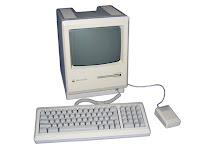January 2019 marks the end of a love affair with the Macintosh computer that goes back all the way to 1985. Last week, I called my college's IT department and asked them to take away my Mac and replace it with a PC. A Dell, to be more precise. The funny thing is that I didn't really leave the Mac as much as they stopped caring if I stayed.
My first exposure to Macintosh computers came as a high school student creating form in the junior high office for my band directors. I was a student aide for them at the junior high, and the computer work often got me out of seventh hour Spanish class.
My first computer purchase was a Macintosh Plus in college at Mizzou. That baby cost me $900 for no hard drive and 1 MB of memory...all that and a nine-inch screen to boot! I wrote most of my college essays, short stories, and my first attempt at a novel on that computer, all of it running and saved on small plastic floppy disks.
Over the years, I've continued to personally purchase Macs, from the eMac to the iMac, and I've insisted on using Macs in my graphic design profession. Even as I gave up my design work at my college, I still had enough departmental design projects on my plate to justify keeping a Mac. But my personal iMac died two years ago—fried processor—and last week was the last straw at work.
Why the change? My Microsoft Office software stopped working on the Mac. It would take as long as five minutes to launch, then freeze up nonresponsive, forcing a restart. It was like 1989 all over again. Adobe Creative Suite software took even longer to start, forever to quit (usually locking up instead of quitting), and making it impossible for me to work at a productive speed on even the simplest documents. Everyday tasks became so frustrating I began to daydream of solving my computer problems with the "Office Space" procedure. (Video NSFW!)
In addition, as I've reached fifty years old, my vision is starting to decline at an accelerated pace, and the 21-inch iMac screen really didn't cut it anymore, even with zooming in on pages. I was going home with severe eye strain and headaches. I've asked IT to provide me with a big-screen monitor to help with the eyestrain. I have my homemade PC (courtesy of my computer-whiz son) hooked up to a 37-inch flat-screen TV, and it doesn't give me any trouble.
It would be easy to blame the change in the Mac on the death of Steve Jobs, and I think that certainly has something to do with the decline in prestige of the Mac computers, but I also think that Apple's corporate leadership has decided to follow the money, focusing their energy on phones, tablets, and internet laptops instead of the old workhorse computers. This is a sound business strategy, I guess, but it feels like a kind of death to me.
You see, I was one of the most foremost Macintosh evangelists that you could ever meet. I could give you a blow-by-blow breakdown of all the reasons why Macs were so much better than PCs. But over time, both computers have changed. Macs have grown static, stuck in the old paradigm of controlling both hardware and software, while PCs pursued the open-source model, emphasizing quantity of sales over quality of price, and in doing so, they have at least met (if not surpassed) Macs in terms of processor speed, memory, graphics, and utility.
I simply cannot make a convincing argument for why Macs are better than PCs anymore. They're just as fast (or faster), can run all the same software (even for graphic design, now that Adobe Creative Suite is cloud-based instead of purchase-and-install), and more versatile. Gamers had a lot to do with these innovations, as Apple ignored the game market...to its own peril.
In the end, I have to be pragmatic about the whole thing. The reason I loved the Mac was not only because it was cooler to have one but also because it worked better than those clunky old PCs. Well, I have to say for myself, these aren't the good old days any longer, and I need a computer that's going to work as fast as I can. And today, that's my new Dell PC.
